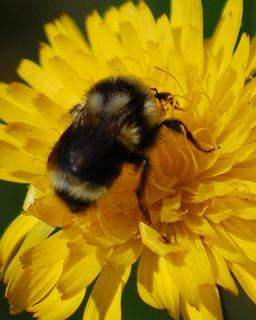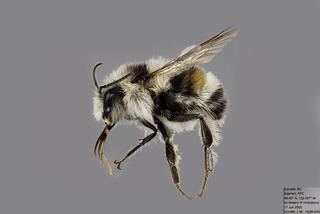Subphylum Hexapoda Rank Species | ||
 | ||
Similar Bombus frigidus, Bombus flavifrons, Bombus centralis, Bombus insularis, Bombus fernaldae | ||
Bombus bifarius, the two-form bumblebee, is a common species of eusocial bumblebee of the subgenus Pyrobombus. B. bifarius inhabits mountainous regions of western North America. Its common name refers to the two dominant color polymorphisms, the nominate and nearcticus polymorphisms, present in the species. B. bifarius has been identified as one of the two species of bumblebee observed to use pheromones in kin recognition. The other is the frigid bumblebee, Bombus frigidus.
Contents
- Taxonomy and phylogeny
- Description and identification
- Sexual dimorphism
- Nests
- Diet
- Distribution and habitat
- Colony cycle
- Mating
- Kin recognition and inbreeding avoidance
- Mate guarding
- Thermoregulation in the nest
- Foraging
- Buzz pollination
- Nectar foraging
- Foraging task specialization
- References

Taxonomy and phylogeny

B. bifarius was first described by Ezra Townsend Cresson in the 1878 Proceedings of the Academy of Natural Sciences of Philadelphia. It is a member of the order Hymenoptera and the family Apidae, which also includes orchid bees, honey bees, and bumblebees. B. bifarius expresses many major color patterns, with the two most observed being the nominate and nearcticus color patterns. Nominate B. bifarius are found from Colorado all the way north to British Columbia, while the nearcticus color pattern are primarily found in western Canada, Alaska, California, Oregon, Idaho, Montana, and Washington. Because of these color polymorphisms and differences in genetic structuring between populations of B. bifarius in various geographic locations, there has been debate as to the future of the taxonomy of these two major color pattern polymorphisms. While currently, these two polymorphisms are considered patterns of the same species, genetic evidence may suggest a case for revising the taxonomic status to reflect these differences.

B. bifarius has been identified as being most similar to the following species: B. ternarius, B. huntii, B. sylvicola, B. melanopygus, B. sitkensis, and B. sandersoni.
Description and identification

B. bifarius has a relatively small body size ranging from 8 to 14 mm (0.31 to 0.55 in) for workers and 15–19 mm (0.59–0.75 in) for queens, with short, even hair covering their bodies. B. bifarius individuals express multiple color polymorphisms; however, many similarities exist between these color variants. Hair on the faces of B. bifarius individuals is usually yellow or white in color and sometimes exhibits black coloration on the top of the head. In at least the lowermost third of the thorax, there is also black coloration. The hindlegs and pollen baskets can be a brownish-orange or black, depending on whether metasomal tergite (abdominal segment) 3 is black or not. In the nominate color variant, metasomal tergites 2 and 3 are red, while in the nearcticus color variant, metasomal tergites 2 and 3 are black.
Sexual dimorphism

Males are similar in size to female workers, ranging from 8 to 13 mm (0.31 to 0.51 in). Their eyes are also similar in size and shape to those of their female counterparts, which is in direct contrast to other species of bumblebee. Colorations on their bodies are similar to those of workers and the queen; however, T3 and T6 are most frequently black in males and can vary between black, red, and yellow in workers and queens.
Nests

B. bifarius nests are made underground or on the surface of the ground. These nests are often small and are made up of one singular open chamber. B. bifarius can also make their nests in abandoned rodent nests.
Diet
B. bifarius forages for pollen and nectar from the following plants: Aster, Centaurea, Chrysothamnus, Cirsium, Epilobium, Ericameria, Haplopappus, Helenium, Lupinus, Melilotus, Monardella, Penstemon, Ribes, Senecio, Solidago, and Symphoricarpos.
Distribution and habitat
B. bifarius is found across mountainous regions of western North America. In the United States, it has been found in parts of Alaska, Arizona, California, Colorado, Idaho, Montana, Nevada, New Mexico, Oregon, South Dakota, Utah, Washington, Wyoming. In Canada, it has been found in Alberta, British Columbia, Manitoba, Northwest Territories, Saskatchewan, and Yukon. B. bifarius makes its home in various habitats, including open grassy fields, parks, prairies, shrubs, and mountainous areas.
Colony cycle
Colonies regenerate annually, with queens emerging from hibernation in the early spring to found one colony per queen. After emerging, queens mate and the first wave of workers is produced, initiating the eusocial phase. In the eusocial phase, exponential growth of the colony occurs and workers help queens expand the size of the colony. Eventually, the eusocial phase gives way to the reproductive phase, in which the offspring produced are sexual offspring. These offspring then leave the nest and mate with non-nestmates, and young queens that have been inseminated enter hibernation until the following spring when they found their new colony.
Mating
B. bifarius queens only mate once during the colony cycle, preferably with a non-related male. Often, the duration of mating interactions between males and B. bifarius queens are long, lasting up to forty-five minutes.
Kin recognition and inbreeding avoidance
B. bifarius and B. frigidus prefer to mate with non-nestmates, so they have evolved a number of strategies to determine which individuals are kin and which are not. For example, environmental cues like proximity to the nest may indicate that a reproductive female is related. However, not all encounters fall under the category of environmental cues; B. bifarius is one of the few bumblebee species that can also determine kin using individually-borne methods. For example, males exhibit a behavior called “patrolling”, in which they mark specific paths with pheromones and “patrol” these paths hoping to encounter a reproductive female that was attracted to the scent. Reproductive females are able to sense these pheromones and are attracted to them.
Mate guarding
B. bifarius males often compete for access to females, which has caused them to evolve strategies to ensure that they successfully complete the mating process with a chosen queen. That mating interactions are prolonged indicates that males “guard” their mate to ensure other males cannot copulate with her. This behavior is costly, however, since prolonged mating with one queen means that males overall engage in fewer mating interactions. Additionally, mate guarding immobilizes the mating pair, making them more susceptible to predatory attacks.
Thermoregulation in the nest
Keeping the nest environment at an optimal temperature is a crucial aspect of survival, especially for developing brood. Studies have shown that B. bifarius worker bees are capable of regulating nest temperature; they do this in a number of ways, namely by changing the rates at which they perform specific behaviors of wing fanning and brood cell incubation. During wing fanning, individuals flap their wings quickly as a means of cooling down their surroundings. Brood incubation involves a coiling of the worker’s body around a brood cell and contracting her muscles so as to transfer heat to her surroundings. Broadly, as the temperature of the nest increases, the rate of brood cell incubation decreases and wing fanning behaviors increase within the nest. However, these behaviors are not universally exhibited by individuals at the same temperatures; some individuals begin incubating at higher temperatures than others, and some begin fanning their wings at lower temperatures than others.
Foraging
Studies have shown that B. bifarius forage in random directions when foraging for pollen and nectar. These bees have mechanisms by which they can recognize which flowers they have already visited. The mechanism appears to be one by which the bee sees open flowers and senses how much pollen is still available in them. Their ultimate strategy for pollen foraging, whether it be through area-restricted searching behavior or moving between flowers near them regardless of quality of bloom, is variable depending on the conditions under which B. bifarius is foraging. For example, in P. gracilis blooms, the quality of bloom can be assessed by B. bifarius at relatively low cost to the individual, so moving to nearby neighboring flowers instead of area-restricted searching yields more energy intake per energy input.
Buzz pollination
B. bifarius, like many other bumblebees, gathers pollen from flowers in a process called "buzz pollination". During buzz pollination, the bee “sonicates” the anthers of the flowers, thereby shaking the pollen from the anthers to be collected in the individual’s pollen sacs. Because of their small size, B. bifarius individuals are known to hang upside-down on the flower when engaging in buzz pollination.
Nectar foraging
Bombus bifarius workers have short proboscides (tongue-like structures), which makes nectar foraging more difficult for them relative to bumblebees with longer proboscides. Therefore, in order to effectively retrieve nectar from plants, B. bifarius individuals often use their short proboscides to lick along the back of nectar ducts of the plant in question. This yields a smaller reward than the rewards obtained with larger proboscides, but not small enough to make nectar foraging ineffective.
Foraging task specialization
Most foragers of the B. bifarius species forage for both nectar and pollen; however, there has been evidence of specialization within foragers, with some collecting only nectar and others collecting only pollen throughout their whole careers as foragers. Studies have shown that foragers that specialize in collecting either nectar or pollen are able to gather more food than those that did not specialize.
